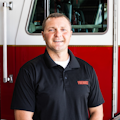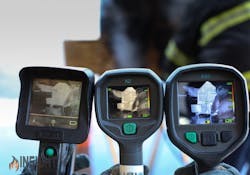Conducting an adequate size-up of any incident to provide for safe, efficient and effective operations. Many cues that might be noticed during the initial size-up of a fire can provide valuable insight, such as the fire’s location, high priority areas for search and unsafe conditions. Size-up also provides an opportunity to perform last-minute reconnaissance of a dynamic situation for which the consequences of poor performance can to the loss of life or, at minimum, increased property loss.
Size-up must be performed not just skillfully but also quickly. Any amount of time that’s sacrificed unnecessarily potentially allows the problem to grow unchecked if resources aren’t deployed and aren’t effective.
A thermal imaging camera (TIC) can give you an enhanced view during size-up. However, for it to do so, you must understand the tool and its proper application.
Opting to use the TIC in this manner is a forward-thinking decision, but the TIC’s information is only as good as the end user’s ability to properly utilize the camera and to interpret its display. In other words, decision must be augmented by knowledge and practice. This ensures that you don’t spend precious time without gaining equally valuable intelligence about what lies before you.
Scanning mechanics
Because it’s imperative for you to know the capabilities of the TIC that you are using (see “Types of TICs”), it’s equally imperative for you to realize that the TIC only can see what you aim it at. This simple and obvious statement is the root for why many thermal cues are missed. In the stressed environment of a fire, one can be hurried into failing to scan the whole scene with the TIC.
Scanning the whole scene begins with building a habit of scanning in the same manner all of the time. The preferred method is to scan the building from bottom to top and completing the scan each time without stopping at the first cue. Starting at the bottom ensures that you don’t stop at the first sign of heat exhausting or collecting at the top of the structure. Finishing the scan every time ensures that you see the full effects of the fire on the entire structure, not just the first thermal cue that presents itself to you.
After you instill the habit of scanning the entire structure, you must learn to scan at the proper speed. If you are in the situation of using a 9-Hz TIC, you must scan much more slowly than when you scan using a 30-Hz TIC. However, with either TIC, the scan must be slow enough to allow your eye to see and your brain to interpret the entire image. With training and experience using the TIC, the amount of time that this takes will decrease, because thermal cues will become apparent to you more quickly.Physical positioning
Physical positioning in relation to the target often is given little thought. Thus, inappropriate physical positioning is a common cause of missing valuable information when using a TIC.
Infrared radiation travels in straight lines; in other words, it won’t move around an object that’s in its path. Because of this, you must be mindful of any object that might obstruct or insulate your view of a heat source. During the size-up of a building, such objects can include shrubbery, outdoor furniture, building additions and vehicles.
Also, because infrared radiation travels in straight lines, when you look at a heat source through an unbroken window, your best view will be from straight on. This brings the full surface of the window and its surrounding area into the picture, covered by the greatest number of pixels.
Study the target
An understanding of how you can better utilize a TIC during size-up only begins with understanding the TIC. You also must understand the object that you are pointing the camera at. Buildings contain many different surfaces, layouts, and areas that might or might not allow heat energy to pass through. If the surface isn’t a good emitter of heat, the amount of heat that’s detected by a TIC will be inaccurate. Surfaces that are smooth and shiny are poor emitters. Surfaces that are dull and rough are the best emitters. Consider the difference between metal roofing and asphalt shingles.
During size-up, the heat that’s generated by a fire that’s inside of a building must travel through the structure itself to be visible to the TIC. However, buildings, particularly of modern construction, aren’t designed to allow this to happen easily. They are designed to keep the interior environment from leaking to the exterior and vice versa. (This makes them energy efficient.) This leads to a lower amount of heat being visible on the exterior to be detected by the TIC.
That said, building construction does allow for this exchange of heat to happen in specific locations, such as where insulation is missing or in a lesser quantity. These specific locations vary based on construction, the condition of insulation, thermal bridging and other variables.
Knowledge and experience
The effective use of a tool requires careful study of how it works and the subject to which it will be applied. TICs are no different. When you carry and use a TIC during size-ups, you allow yourself the opportunity to see information that truly is unseen another way.
If you gain the proper knowledge and experience, you will have a higher success rate of collecting information and at a faster tempo. In the end, this allows you to locate the fire, forecast its growth and assess your progress toward achieving extinguishment.
Types of TICs
Thermal imaging cameras (TICs) are divided into two distinct categories: situational awareness and decision-making. When choosing a camera to use for size-up purposes, you always should choose a decision-making camera when it’s available. Decision-making TICs have faster refresh rates and show greater detail than their situational awareness counterparts.
I believe that a refresh rate that’s faster than 30 hertz (Hz) is best suited for any circumstance in which time-compressed decision-making is necessary.
The human eye sees at a rate of 27 Hz. The farther that the refresh rate falls below what the human eye is capable of, the more perceived lag in the TIC’s output. This isn’t only frustrating for the user, but during size-up, it could cause you to miss something if it “freezes” or “lags” at the wrong moment.
Decision-making TICs provide greater detail, largely because they produce a higher resolution image. A TIC that uses a detector that has a resolution of 320 x 240 (the highest in the fire service market) creates a picture that uses 76,800 individual pixels. On the other hand, 9-Hz TICs have a resolution of 160 x 120 (the lowest in the fire service market) and use 19,200 pixels to make up an image. This equates to a 75 percent difference in pixels and, thus, a significant difference in detail.
This difference in detail affects the size-up in two ways. First, thermal cues on the exterior of fire buildings often won’t be as easily visible via situational awareness TICs as they are with decision-making units. Second, increases in distance from the building affects the situational awareness TICs more than decision-making models. This is because one pixel on the 160 x 120 sensor tries to show what four pixels show on the 320 x 240 sensor.
TIC Application Modes
Many fire service thermal imaging cameras (TICs) come with different application modes. Typically, it isn’t recommended to utilize any of these modes on the fireground. Size-up is an exception to that rule.
Some TICs utilize special modes that are useful to highlight areas of concern on the exterior of the structure. These modes vary by name, depending on the manufacturer, and not all TICs have a useful one.
Good application modes for use during size-up have a common key attribute: They decrease the temperature threshold for colorization or the use of a color alarm. The use of color is meant to draw your attention to an area that’s heated to a degree that warrants attention or action. These modes lower that threshold for colorization to a maximum starting point of 200 degrees.
About the Author

Joey Baxa
Joey Baxa has been a firefighter for 15 years. He currently holds the rank of captain with the Buckhannon, WV, Fire Department. Baxa also is an instructor with Insight Training LLC and is an adjunct instructor with West Virginia University Fire Service Extension.

